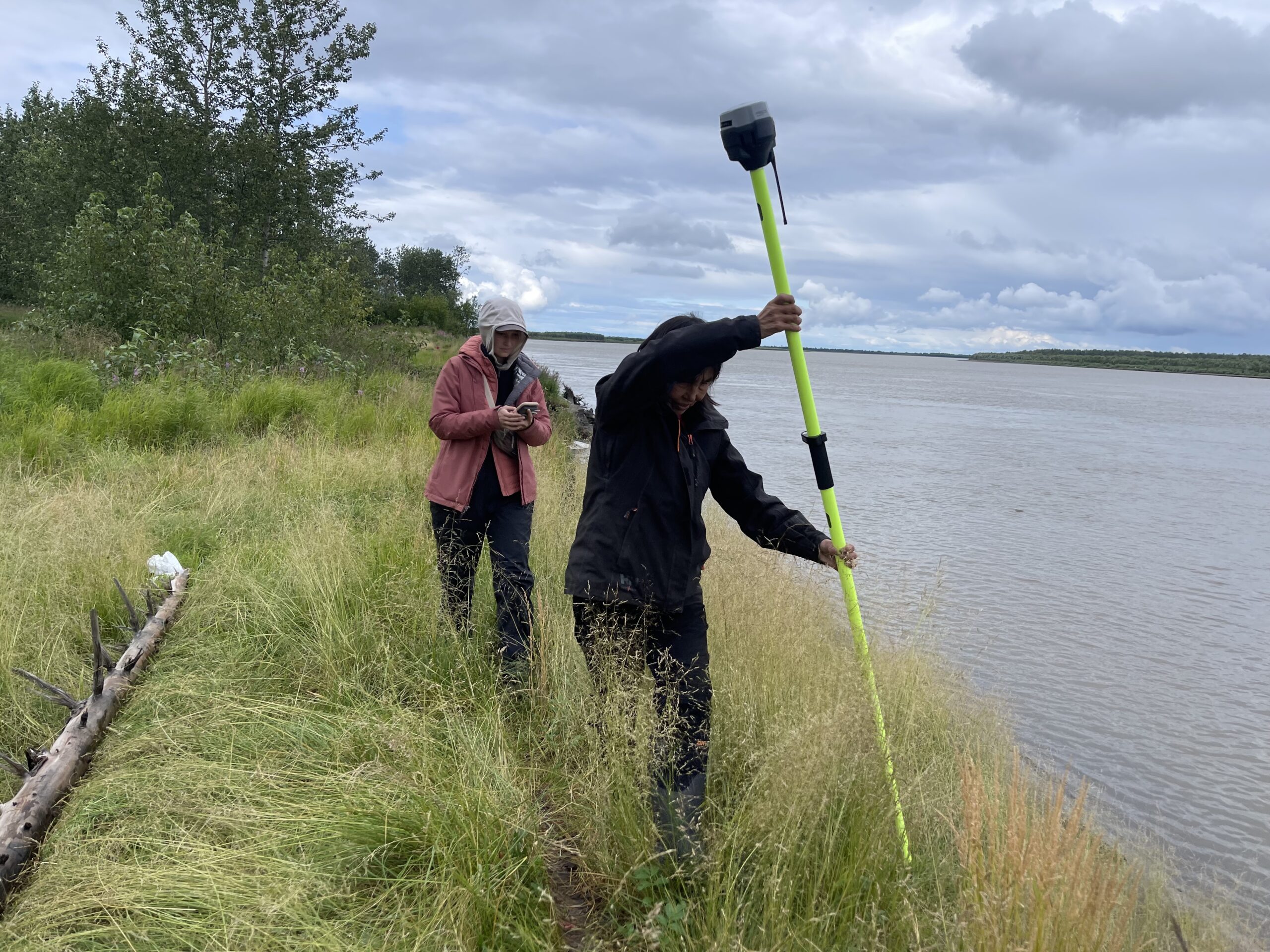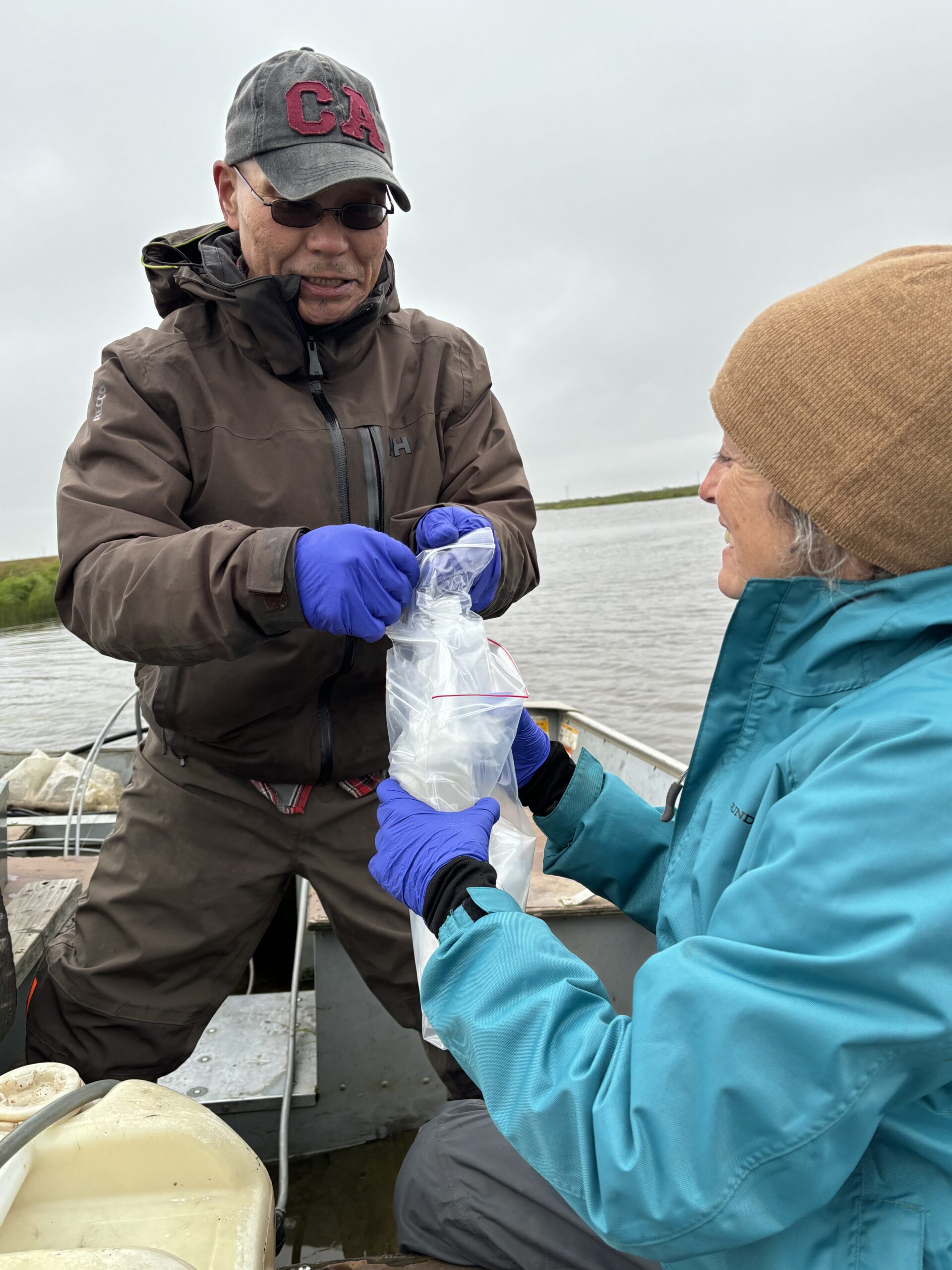Thawing permafrost is an existential threat for Alaska communities. This nonprofit is trying to help monitor it.
Description
<figure class="aligncenter size-full">
 <figcaption class="wp-element-caption">Tiffany Windholz and Maamcuk Foss walking along the bank of the Kuskokwim River mapping the ongoing erosion in Akiak. (Darcy Peter)</figcaption></figure>
<figcaption class="wp-element-caption">Tiffany Windholz and Maamcuk Foss walking along the bank of the Kuskokwim River mapping the ongoing erosion in Akiak. (Darcy Peter)</figcaption></figure><figure class="wp-block-audio"></figure>
Maamcuk Foss walked along the edge of the Kuskokwim River in Akiak. It was storming out, but she had bigger concerns.
“This is all falling in, this is all new,” she said, gesturing toward the bank of the river, where big chunks of land had broken off, straight into the water. “Within one week we just probably lost about 20 feet.”
Foss is the liaison for the Permafrost Pathways project in her hometown of Akiak. Scientists from the nonprofit joined Foss last month to measure the erosion along the bank using high resolution GPS, so they can keep track of how much land is melting away into the river. They can also use the data to map where it’s likely to erode further, which can help the community know if homes or other infrastructure are in danger.
The Permafrost Pathways team is doing work like this across multiple Alaska communities where permafrost thaw is causing big problems. Houses and roads are sinking into the ground. River banks, like in Akiak, are disintegrating. Permafrost Pathways started two years ago with the goal of mapping the permafrost thaw – and putting that data into the hands of the communities themselves. As human-caused climate change continues to warm the region, and the permafrost melts more and more, the project is expanding.
“Permafrost thaw impacts everything,” said Darcy Peter, arctic adaptation lead with Permafrost Pathways. “It impacts housing, electricity, food security, water quality, everything.”
This summer, scientists visited three communities they hadn’t been to yet: Akiachak, Kwethluk and Nelson Lagoon. They also continued their partnership with several others, including Akiak, doing things like repairing a broken temperature sensor and collecting water samples. All are predominantly Alaska Native communities built on top of ground that has remained frozen for hundreds of years. As that permafrost thaws, the effects can be detrimental.
“When it thaws, it sinks, and it gets like muck, like a big muck pit, and so many of their homes are sinking and they’re impacted by flooding,” said Sue Natalley, an ecologist and lead of the Permafrost Pathways project. “If you step off the boardwalk, you’ll fall in above your knee. It’s like quicksand, but mud.”
<figure class="wp-block-image size-full is-resized">
 <figcaption class="wp-element-caption">Morris Alexie and Sue Natali collect water quality samples near Nunapitchuk. (Jessica Howard)</figcaption></figure>
<figcaption class="wp-element-caption">Morris Alexie and Sue Natali collect water quality samples near Nunapitchuk. (Jessica Howard)</figcaption></figure>Communities control the data
Permafrost Pathways is funded through the TED Audacious Project, a philanthropic program that is housed by the organization that does TED talks.
The team at Permafrost Pathways tailors their work to each communities’ specific needs. In many communities they send scientists to measure temperatures in the ground and teach locals to collect the data themselves. But other communities have asked for data on erosion or flooding, which are consequences of permafrost thaw.
“Everything we do is owned by the tribes,” Peter said. “All the data that we collect, all the mapping that we do, all the Indigenous knowledge that we hear, it goes straight back to the community. Once we install this scientific equipment, they’re the ones who run it and check on it and take the data off. So they’re their own scientists, their own map makers.”
Peter said it’s important for each community to have data about their permafrost because most will have to make a very difficult decision: whether they can “protect in place” or whether permafrost degradation will force their community to relocate off land many of their families have lived on for generations.
Peter herself is Alaska Native, and grew up in Beaver, a small Koyukon village in the Interior that is also affected by permafrost thaw. She said the idea of leaving home is particularly difficult for Native communities.
“We’re so in touch with the land and we know the land so well,” Peter said. “I know all the surrounding woods and cricks and everything surrounding Beaver. It’s just home. I can’t imagine ever leaving that, like, that’s where my grandpa’s grandpa’s grandpa’s grandpa has been, and to have to relocate somewhere else, even if it’s nearby, wouldn’t want to do that ever.”
Moving a village
Nunapitchuk, in the Yukon-Kuskokwim Delta, is another one of the communities that Permafrost Pathways has partnered with. The community recently made the difficult decision to move to a new village site about a mile away.
“It’s like things have gotten so inhabitable and unsafe that they didn’t have a choice but to move,” Peter said.
<figure class="aligncenter size-full"><img loading="lazy" decoding="async" width="2560" height="1920" src="https://media.alaskapublic.org/wp-content/uploads/2024/09/Nunapitchuk1-Aug2024-JessicaHoward-WoodwellClimateResearchCenter-scaled.jpeg" alt="three people, two of whom are carrying big backpacks, walk along a wide boardwalk. there are colorful buildings in front of them." class="wp-image-408847" srcset="https://media.alaskapublic.org/wp-content/uploads/2024/09/Nunapitchuk1-Aug2024-JessicaHoward-WoodwellClimateResearchCenter-scaled.jpeg 2560w, https://media.alaskapublic.org/wp-content/uploads/2024/09/Nunapitchuk1-Aug2024-JessicaHoward-WoodwellClimateResearchCenter-300x225.jpeg 300w, https://media.alaskapublic.org/wp-content/uploads/2024/09/Nunapitchuk1-Aug2024-JessicaHoward-WoodwellClimateResearchCenter-600x450.jpeg 600w, https://media.alaskapublic.org/wp-content/uploads/2024/09/Nunapitchuk1-Aug2024-JessicaHoward-WoodwellClimateResearchCenter-150x113.jpeg 150w, https://media.alaskapublic.org/wp-content/uploads/2024/09/Nunapitchuk1-Aug2024-JessicaHoward-WoodwellClimateResearchCenter-768x576.jpeg 768w, https://media.alaskapublic.org/wp-content/uploads/2024/09/Nunapitchuk1-Aug2024-JessicaHoward-WoodwellClimateResearchCenter-1536x1152.jpeg 1536w, https://media.alaskapublic.org/wp-content/uploads/2024/09/Nunapitchuk1-Aug2024-JessicaHoward-WoodwellClimateResearchCenter-2048x1536.jpeg 2048w, https://media.alaskapublic.org/wp-content/uploads/2024/09/Nunapitchuk1-Aug2024-JessicaHoward-WoodwellClimateResearchCenter-80x60.jpeg 80w, https://media.alaskapublic.org/wp-content/uploads/2024/09/Nunapitchuk1-Aug2024-JessicaHoward-WoodwellClimateResearchCenter-696x522.jpeg




